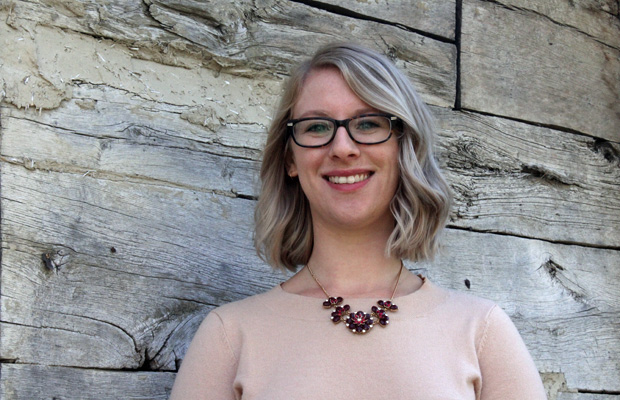Village News
Question and Answer With Jenna Klassen

Jenna Klassen joined our team here at Mennonite Heritage Village (MHV) in early October as our new Assistant Curator. Some of our volunteers and members of the public have had a chance to meet Jenna, but for those who have not, I thought I would sit down with her for a “Question and Answer” session about museum life and her first few weeks here at MHV.
What drew you to MHV?
The beginning of my experience with MHV began when I was a kid. I visited many times on school field trips, as well as during Pioneer Days when my grandpa gave wagon rides with his horses in the village. I was always fascinated by the heritage buildings in the village, imagining how they had once been used and lived in by their owners so many years ago. My interest in history and museum work has been ongoing for many years, and I have been working in the museum field for about three years, mostly in smaller, community museums. Working as the Assistant Curator at MHV gives me the opportunity to explore my interest in Mennonite and immigration history, as well as further my skills and experience within the museum field and in the role of curating.
What has been the highlight of your first two weeks at MHV?
One highlight has been touring the heritage buildings in the village in more detail than in past visits to the museum when I was only a visitor. As part of familiarizing myself with various aspects of the Assistant Curator position, I have done some in-depth reading of the history of the various buildings, including the architectural and structural features of each that made them functional (practically and culturally) for the early Mennonite settlers. Part of this in-depth exploration of the buildings is familiarizing myself with the conservation and restoration projects that have been undertaken, or still need to be undertaken. For example, the Waldheim house recently underwent extensive restorations that were completed this last summer. The Waldheim house demonstrates the importance of these restoration projects in order to preserve these heritage buildings, so they can continue to be part of our Mennonite village. A building that requires extensive restoration is the Peters’ Barn, which is attached to the Waldheim House. Although it looks to be in pretty good shape from the outside, there is much to be done on the inside for it to be accessible and open to museum visitors. As a curator, projects such as these are challenging but the final product is even more satisfying. I am looking forward to contributing to larger projects such as these during my time at MHV!
What projects are you working on at MHV at the moment?
Since the outdoor village has closed for the season, the village buildings need to be prepared for the winter. This week I have been going around to each building in the village to take out the linens (bedding, curtains, tablecloths, etc.), remove the old straw from the mattresses in the village houses, take out the wall clock from the Chortitz house, and other items that need to come indoors for the winter. This is a part of preserving the objects that are on display when the village is open during the spring and summer months. It also gives us the opportunity to have everything neat and clean for when we open next spring. The linens will be washed, new curtains sewn and hung, and mattresses stuffed with fresh straw. It also allows me to work outside on a beautiful fall afternoon!
You’re undertaking some unique research with part of the MHV collection right now. Can you tell me a bit about that project?
I am currently working at MHV in two different roles. In addition to working part-time as Assistant Curator, I am still also a student, undertaking research for my Master’s thesis, using the MHV’s artefact collection as my primary source. Specifically, I am looking at immigration through material culture, using the artifacts brought to Canada by the “Russländer,” the Mennonites who left Ukraine (or, southern Russia, as they remembered it) in the 1920s. I am analyzing around five hundred objects that range from children’s toys to clothing to photographs to teacups. Using these objects, I am exploring what they meant to the people who brought them all the way to Canada, kept them within the family for generations, and then finally donated them to the museum collection.
And finally, the question every curator gets asked: What is an interesting artifact that you have worked with so far?
Since I am still pretty new at MHV in my role as Assistant Curator, I have actually had more interaction with the collection through my role as a researcher. Currently, I am photographing the artefacts that I will be using for my thesis project. One of the interesting artefacts I’ve come across is a porcelain teacup that had once been broken in many pieces, but was stapled back together with thick, brass staples. This piece is interesting to me for my thesis because it suggests that the teacup meant a lot to the person it belonged to, so much in fact that they put it back together, and then packed it with their other belongings to bring to their new home in Canada. Items like this can demonstrate how objects hold meaning to the people they belong to.
Thanks, Jenna. Although our outdoor village is now closed, our indoor galleries are still open. If you have not yet had an opportunity to take in our 2017 exhibit, Storied Places, we invite you to come and explore the stories that have shaped the Mennonite connection to place in Manitoba. While you’re here, please take a moment to share one of your own stories at our “Storied Map of Steinbach” station in the gallery.




